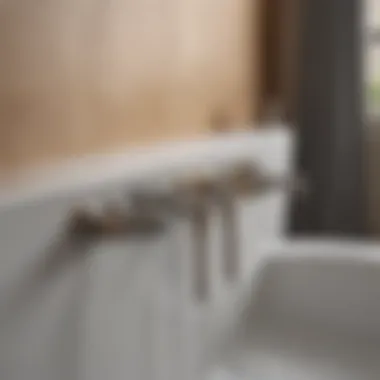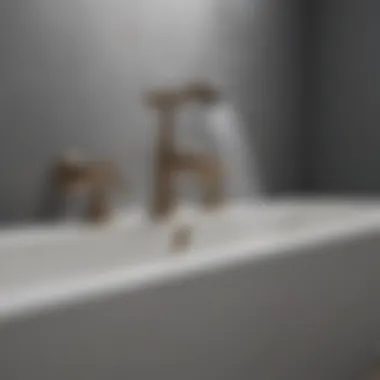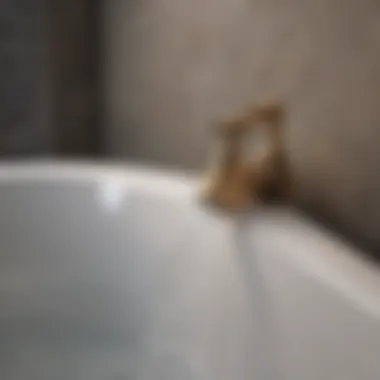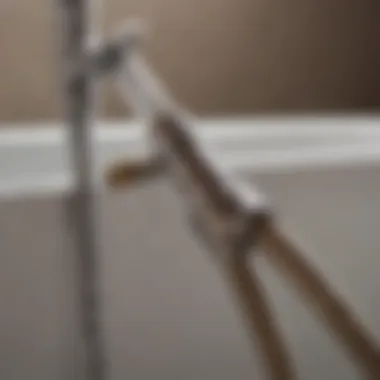Connecting Comfort: Hose Attachments for Bathtub Faucets


Intro
In any modern bathroom, the integration of functional design is crucial. One such component that often goes overlooked is the hose attachment connecting to bathtub faucets. Understanding these hoses can significantly enhance your bathing experience, making it not just a routine activity but a moment of relaxation and comfort.
Hoses serve various purposes, from directing water flow to providing flexibility in access and usage. With the right hose attachments, homeowners can ensure that their bathtubs not only function efficiently but also contribute to a soothing atmosphere. This guide provides a detailed look into the types of hoses available, their installation, maintenance, and troubleshooting tips.
As more homeowners invest in their bathrooms, prioritizing the right hose attachments becomes pivotal. Providing clarity on options available helps in making informed decisions that are both practical and aesthetic, impacting the overall bathing experience positively.
Trending Styles
When considering hose attachments for bathtub faucets, the styling options can influence the choice of hose design and functionality. In the current market, two prominent styles are worth noting: modern minimalism and cozy rustic.
Modern Minimalism
This style emphasizes clean lines and uncluttered designs. Hoses in this category often feature sleek, chrome finishes and straightforward mechanics, aligning well with contemporary bathroom designs. Minimalist hose attachments provide simplicity and elegance, allowing the bathroom's overall aesthetic to shine without unnecessary embellishments.
Cozy Rustic
In contrast, cozy rustic styles seek to bring warmth and charm into the bathroom. Hoses in this environment might incorporate natural materials or finishes that mimic wood or stone. Such hoses offer a touch of storytelling in design, making them suitable for homes that embrace traditional or vintage themes. The installation often reflects artisanal craftsmanship, adding character to the bathing area.
Color Palettes
Colors play a vital role in how hose attachments can enhance the overall room decor. A well-thought-out color palette can elevate the atmosphere of a bathroom.
Calming Neutrals
Using calming neutral colors provides a serene backdrop. Shades like beige, soft grays, or whites work well with both modern and rustic styles. Hoses in muted tones can seamlessly blend into the bathroom, letting other features of the décor stand out.
Bold Accents
Alternatively, bold accents can add a striking focal point. Hoses in vibrant colors or unique textures can serve as a statement piece. A bright red or deep blue hose may create a surprising contrast against a neutral setting, drawing attention and enhancing visual interest.
"Selecting the right hose attachment not only serves a practical purpose but also enhances the aesthetics of your bathroom space."
Understanding Bathtub Faucet Connections
In this section, we explore the indispensable link in your bathtub setup: hose connections. These connections serve as a bridge between your faucet and the hose, allowing water to flow freely. Understanding the intricacies of these connections ensures a seamless bathing experience. Misunderstandings about hose connections can lead to leaks or reduced water pressure. Aligning your expectations with these details can enhance comfort and efficiency during your baths.
The Importance of Proper Hose Connections
Proper hose connections are not merely a matter of convenience; they are crucial for both functionality and safety. A solid connection will ensure that water flows efficiently, preventing splashes and wastage. An improperly attached hose can lead to corrosion, leaks, and significant water damage over time. Additionally, frequent exposure to moisture can promote mold growth, posing health risks to your household. Secure hose connections also regulate water pressure, creating a more enjoyable bathing experience. Therefore, investing in quality hose fittings cannot be overstated.
Overview of Bathtub Faucet Types
To connect hoses effectively, one must first understand the different types of bathtub faucets available. There are distinct styles, each with unique features that can affect hose compatibility. The most common types are:
- Wall-mounted faucets: These set directly on the wall and require a specific hose length to reach the tub.
- Deck-mounted faucets: Positioned on the tub's rim, their hoses often need to account for the extra distance.
- Freestanding faucets: These require careful measurement as they stand independently from the tub.
Recognizing the nuances of each faucet type helps homeowners select the appropriate hose, ensuring maximum performance and enjoyment.
Types of Hoses for Bathtub Faucets
Understanding the types of hoses available for bathtub faucets is crucial for homeowners who want to optimize their bathing experience. Different hoses offer distinct features that cater to specific needs, making it essential to choose wisely. These choices impact not only the functionality of the faucet but also the aesthetics and ease of use in the bathroom. Therefore, knowledge of hose types allows users to select attachments that enhance comfort and ensure longevity.


Flexible vs. Rigid Hoses
Flexible hoses are designed to bend and maneuver easily, allowing for a more versatile installation. They adjust to various positions and can connect to faucets in hard-to-reach areas. Their flexibility allows for easy handling during daily use. On the other hand, rigid hoses provide a more fixed and durable connection. They maintain a consistent shape which can be preferable in some technical installations where movement is limited. Each choice has its merits, depending on the specific requirements of the setup and user preference.
Materials Used in Hose Manufacturing
Rubber
Rubber is a primary material used in hose manufacturing because of its flexibility and resistance to wear. It is often chosen for its ability to withstand different water temperatures, which makes it a favorable option for bathtubs. One key characteristic of rubber is its natural elasticity, allowing it to stretch and return to shape without damage. This makes rubber hoses durable for prolonged use. However, they can be susceptible to degradation from certain chemicals and sunlight exposure.
Stainless Steel
Stainless steel hoses are known for their strength and resistance to corrosion. They have a sleek appearance that many homeowners prefer for aesthetic reasons. Their key characteristic lies in their durability; stainless steel hoses will typically last longer than rubber or plastic options. This material also resists kinks and bends, maintaining water flow effectively. However, they can be heavier and may require more robust mounting hardware during installation.
Plastic
Plastic hoses offer a lightweight and cost-effective solution for bathtub connections. They are usually less expensive compared to other materials, making them popular among budget-conscious consumers. A notable benefit of plastic hoses is their resistance to rust and corrosion. However, they may not be as durable as rubber or stainless steel, potentially leading to issues over time. Users must consider this when selecting a long-term solution.
Reinforced Materials
Reinforced materials provide enhanced strength and durability, making them a suitable choice for heavy-duty applications. Their key characteristic is the added layers or materials that bolster their pressure handling capacity. These hoses are beneficial in situations where high water pressure is a concern. On the downside, they can be less flexible compared to standard hoses, making installation a bit more challenging in tight spaces.
Length and Diameter Specifications
Choosing the correct length and diameter for your hose is vital for ensuring optimal water flow and connection to the faucet. Length affects how far the water travels, while diameter influences the volume and pressure. Appropriate specifications prevent problems like leaks or insufficient water delivery. Customers should consult manufacturer guidelines or existing installations to select hoses that fit their needs precisely.
Choosing the Right Hose for Your Bathtub Faucet
Selecting the appropriate hose for your bathtub faucet is a critical step that impacts both functionality and overall bath experience. A good hose ensures that water flows efficiently without leaks or interruptions. Incorrect fittings can lead to frustration, wasted water, and even damage to the bathtub or surrounding area. Moreover, the right hose can significantly enhance your enjoyment of your bathing routine.
Factors to Consider When Selecting a Hose
Choosing a hose requires consideration of several key factors:
- Length: Measure the distance from your faucet to the desired endpoint. A hose that is too short might not reach, while an overly long hose can cause kinks and reduce water pressure.
- Diameter: Ensure the diameter matches the faucet’s output. A hose too small can restrict flow, while one too large may not fit properly.
- Compatibility: Be aware of your faucet’s connection type. Some hoses may not fit certain faucets without adapters.
- Material: Different materials offer varying durability and flexibility. Choose based on your specific needs for flexibility and strength.
Compatibility with Various Faucet Designs
Compatibility is paramount when choosing a hose. Bathtub faucets come in various designs, including single-handle, double-handle, and pull-out options. A hose must fit correctly to function properly. Some designs may require special adapters or fittings. For example, if you have a Delta or Moen faucet, check the specific model to ensure you purchase the right hose. This step can save you from frustration during installation.
Assessing Quality: What to Look For
Quality should never be compromised when selecting a hose. Here are some indicators to consider:
- Material Strength: Choose hoses made from durable materials such as reinforced rubber or stainless steel. This ensures longevity and resistance to wear.
- Connection Fittings: Look for solid and reliable fittings. Plastic fittings can wear out quickly, while metal options generally offer a stronger and more secure connection.
- Flexibility: A quality hose should be flexible enough to avoid kinks while remaining sturdy under pressure. An overly rigid hose can lead to stress at the connection points.
- Warranty: Consider products that come with a warranty or guarantee. This can provide peace of mind about the hose’s durability and performance over time.
Remember: Investing in a quality hose tailored to your specific faucet design minimizes issues in the long run.
By taking care in the selection process and considering the all mentioned factors, homeowners can make informed decisions that contribute to a smoother and more pleasurable bathing experience.
Installation Process for Bathtub Faucet Hoses
The installation process for bathtub faucet hoses is essential for ensuring the functionality and efficiency of your bathing experience. Proper installation not only guarantees optimal water flow but also minimizes the risk of leaks and water wastage. Understanding the steps involved can help homeowners save time and money in the long run. A well-installed hose connection enhances overall user experience, offering both convenience and reliability.
Tools Required for Installation


Before beginning installation, it is crucial to gather the necessary tools. Having the right tools at hand makes the procedure smoother. Here are the tools you will need:
- Adjustable Wrench: To securely tighten the connections without damaging the fixtures.
- Screwdriver: Useful for tightening screws on the faucet assembly.
- Plumber’s Tape: Helps in sealing threaded connections to prevent leaks.
- Bucket: To catch any residual water during disconnection or installation.
- Hose Clamps (if necessary): To secure the hoses tightly in certain configurations.
Step-by-Step Installation Guide
The installation of bathtub faucet hoses can seem daunting, but breaking it down into manageable steps simplifies the process. Here is a concise guide:
- Turn Off Water Supply: Before starting, make sure to turn off the water supply to avoid any accidents.
- Remove Existing Hose: Use the adjustable wrench to disconnect the old hose from the faucet and the bathtub spout. Be sure to collect any residual water in your bucket.
- Clean the Connection Points: Wipe down the threads of the faucet and spout to remove any debris or remnants of old plumber's tape.
- Prepare New Hose: If using plumber's tape, wrap it around the threads of the faucet and the spout. This ensures a secure fit.
- Connect the New Hose: Attach one end of the new hose to the faucet and the other to the spout. Make sure to tighten the connections securely using the wrench.
- Check for Leaks: Turn the water supply back on slowly. Inspect the fittings for any signs of leaking. If there are leaks, re-tighten the fittings.
- Final Test: Run the faucet and ensure water flows smoothly without interruptions.
Common Mistakes to Avoid During Installation
When installing bathtub faucet hoses, certain pitfalls can lead to performance issues. Awareness of these common mistakes is key:
- Neglecting to Turn Off Water Supply: Skipping this step can lead to mess and potential damage.
- Ignoring the Use of Plumber’s Tape: Failing to use plumber's tape on threaded connections often results in leaks.
- Over-tightening Connections: This can damage the hose or the faucet threads, leading to future breakdowns.
- Forgetting to Inspect for Leaks: Always check for leaks after installation to prevent water damage.
Proper installation is the first step toward a functional and effective bathing experience. Ensuring secure connections can save time and resources.
With these guidelines, you can achieve a successful installation of your bathtub faucet hoses. Being mindful of the tools required, maintaining stepwise discipline during setup, and avoiding common errors lead to an optimal bathing setup.
Maintenance of Bathtub Faucet Hoses
Maintaining bathtub faucet hoses is key for ensuring functionality and longevity of your bathtub setup. Regular maintenance not only prevents unexpected leaks and pressure issues but also enhances the overall bath experience. Homeowners who pay attention to their hoses can save on costs related to repairs and replacements. Neglecting hose maintenance can lead to bigger issues over time, such as permanent damage or health risks associated with leaks.
Regular Inspection and Care
Conducting regular inspections is essential for the upkeep of bathtub faucet hoses. It is recommended to check hoses at least once every few months. During inspections, users should look for signs of wear, such as cracks, bulges, or thinning in the material. Additionally, inspect the connections for any looseness and tighten if necessary. Keeping hose connections secure is crucial to avoid leaks. Notably, regular inspections help catch problems early before they escalate into more significant ones. When hoses are cared for properly, they can serve their purpose effectively for years.
Cleaning Tips for Hoses
Effective cleaning methods can prolong the life of bathtub faucet hoses. Here are some practical tips for maintaining cleanliness:
- Use mild soap and water: A gentle soap solution can remove grime without damaging the material. Avoid harsh chemicals as they may lead to deterioration.
- Soft cloths or sponges: Use soft cloths or sponges to clean the exterior of hoses. This prevents scratching and keeps hoses looking new.
- Avoid heavy-duty cleaners: Stick to gentler cleaning products to ensure the longevity of the hose material.
Cleaning should be performed periodically, especially in households with hard water. Mineral build-up can affect water flow and even harm the hose over time.
Identifying Wear and Tear
Recognizing wear and tear is vital for maintenance. Homeowners should be familiar with what signs to look for:
- Color fading: Discoloration can indicate material degradation.
- Cracks or splits: Any visible damage should prompt an immediate replacement.
- Pressure inconsistencies: Noticeable changes in water pressure can signal that a hose is either clogged or damaged.
If you observe any of these indicators, it may be time to consider replacement to avoid further complications. Taking proactive measures reduces the risk of unexpected issues and helps keep your bathing environment comfortable.
Regular maintenance of hoses enhances safety and longevity, allowing for a more enjoyable bathing experience.
Troubleshooting Common Issues
Understanding and effectively troubleshooting common issues with bathtub faucet hoses is crucial for maintaining a comfortable bathing environment. Problems such as leaks and pressure inconsistencies not only disrupt the bathing experience but can also lead to more significant plumbing issues if left unresolved. Mastering these troubleshooting techniques allows homeowners to ensure smooth operation of their bathtub fixtures, saving time and potential costs associated with professional repairs.
Leaking Hoses: Causes and Solutions
Leaky hoses are one of the most common issues faced by homeowners. These leaks can arise from a variety of factors. The most noticeable cause may be worn-out seals or gaskets. Over time, these components can degrade, resulting in water escaping from the joint between the hose and the faucet.


Another common cause of leaks is improper installation. If the hose is not threaded correctly onto the faucet or if it has been cross-threaded, it can lead to an improper seal, allowing water to seep out. Also, check for any visible damage in the hose itself, such as cracks or kinks that could compromise its integrity.
Solutions to Leaking Hoses:
- Inspect Seals and Gaskets: Replace any worn or damaged seals promptly.
- Reinstall Hose: Carefully uninstall and reinstall the hose to ensure a proper connection.
- Replace Damaged Hoses: If damage to the hose is significant, consider purchasing a new hose.
Pressure Problems: Assessing Hose Performance
Pressure issues can affect the quality of water flow significantly. Low water pressure commonly results from blockages or a buildup of sediment in the hose. Limescale and mineral deposits can restrict water flow. Conversely, high pressure can damage plumbing fixtures and leads to potential leaks.
Assessing hose performance requires today’s fixtures to be checked regularly. One effective method is to observe the water flow during usage. If the flow seems weak, investigate the hose and any attachments for blockages. Another consideration is the faucet aerator, which may need cleaning.
Steps to Assess Performance:
- Check for Blockages: Inspect both the hose and the faucet for debris.
- Test the Flow: Note whether the pressure fluctuates significantly during use.
- Clean Aerators: Soak faucet aerators in vinegar to remove limescale buildup.
Replacement: When is it Necessary?
Replacement of hoses may be necessary under several conditions. If leaks persist despite repairs, or if hoses show signs of severe wear and tear, it is wise to consider a replacement. Additionally, if the hose is outdated, investing in a modern hose that matches current standards can provide better performance.
Homeowners should also evaluate if the hose isn't compatible with other fixtures. Compatibility is vital for optimal performance and safety as mismatched hoses can lead to serious plumbing issues.
Indicators for Replacement:
- Persistent leaks unable to be repaired.
- Severe wear signs, such as cracks or fraying.
- Notably reduced water pressure despite cleaned systems.
In summary, keeping bathtub hoses in good working order will enhance your bathing experience. Regular checks and timely replacements can save homeowners stress and prevent further issues down the line.
By understanding these aspects of troubleshooting bathtub faucet hose issues, homeowners can confidently maintain their plumbing fixtures. Doing so not only contributes to a soothing bath environment but also extends the life of their faucet systems.
Enhancing the Bath Experience with Quality Hoses
When considering a relaxing bath, often the focus is on water temperature, bubbles, or the ambient environment. However, the role of hoses connecting the bathtub faucet is vital. Quality hoses contribute significantly to the overall bathing experience. They ensure that water flow is consistent and can be adjusted as needed, allowing for better control over the bathing process.
Investing in robust and reliable hoses can enhance not just functionality but also comfort. A well-chosen hose allows for the seamless integration of shower heads and other attachments. This adaptability can transform a standard bathing routine into a more versatile experience.
Integrating Shower Heads and Hoses
Integrating shower heads with hoses can provide a multifunctional bathing setup. A quality hose connects the shower head to the faucet, allowing for diverse water delivery methods. Homeowners should consider the convenience of adjustable shower heads, which can offer different spray patterns. These range from a gentle mist to a more powerful spray, catering to different preferences or needs. This also represents a flexibility that enhances comfort.
When selecting hoses for such integration, it is crucial to ensure compatibility. Not all hoses work seamlessly with every shower head, so attention to details like connection sizes and threading types is important. The installation should also be straightforward, minimizing the potential for leaks or other issues.
Water Pressure Considerations
Water pressure plays an essential role in the effectiveness of hoses and shower head combinations. Insufficient pressure can lead to a disappointing experience, resulting in weak flow and inefficient rinsing. Homeowners should assess water pressure levels before making any purchases. Some hoses are designed specifically to optimize flow, maintaining pressure regardless of the shower head settings.
In some cases, pressure-related problems can arise from the piping inside the home rather than the hoses themselves. It may be beneficial to investigate existing plumbing setups to avoid issues later. A balanced water pressure ensures a satisfying and consistent flow, improving the comfort and functionality of the bath. An exacerbation of low pressure may also necessitate a reconsideration of hose quality or size, leading to an upgrade.
"Quality hoses are not just a functional necessity; they fundamentally enhance the bathing experience, marrying comfort and efficiency seamlessly."
The End: Investing in Quality Hose Connections
In the realm of bathroom fixtures, the significance of hose attachments for bathtub faucets is often overlooked. However, making informed decisions when it comes to these components can greatly enhance both the functionality and longevity of your bathing experience. This article has explored various aspects that surround hose connections, from types and materials to installation and maintenance, culminating in the essential point: investing in quality.
Quality hose connections do not just serve a functional purpose; they also ensure that your bathtub operates efficiently. By selecting hoses made from superior materials, such as stainless steel or heavy-duty rubber, you reduce the risk of leaks and inevitable performance issues. Furthermore, these hoses are often designed to withstand wear and tear, thereby extending the life of your bathtub faucet system.
When considering hose attachments, it is crucial to evaluate their compatibility with your specific faucet design. The right fit contributes significantly to the effectiveness of water flow, which directly influences your bathing experience. A well-fitted hose minimizes the chances of malfunction and provides peace of mind for consistent performance.
Another important aspect involves regular inspections and maintenance checks. Quality hoses are generally easier to clean and maintain. This can prevent buildup and ensure that you have a steady flow of water whenever needed.
Investing in high-quality hose connections is not merely a transaction; it is a commitment to enhancing your overall comfort.















